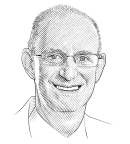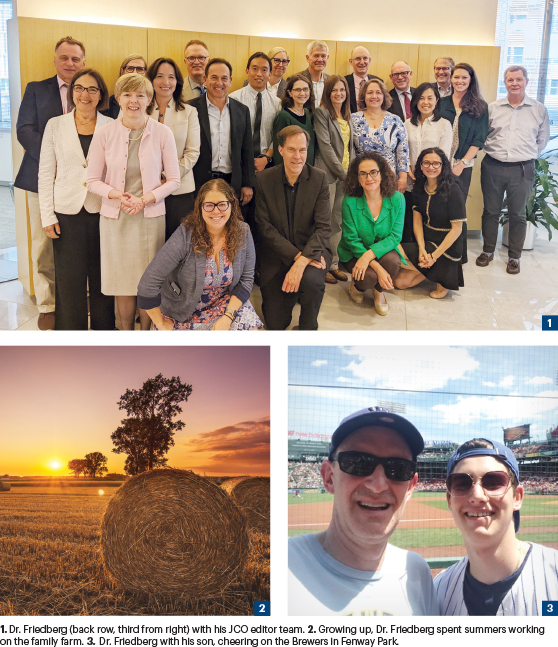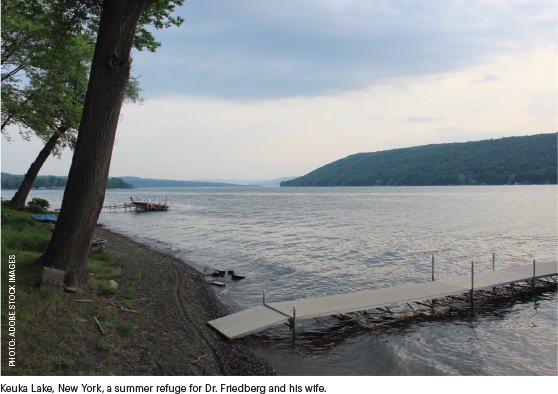Jonathan W. Friedberg, MD, MMSc, Director of the James P. Wilmot Cancer Institute, grew up in a suburb of Milwaukee. While his school friends were attending camp, he spent his summers working on the family farm. “Perhaps the hardest work I’ve ever done was haying on a hot, humid night in July, trying to beat the rain to harvest the hay. It was a modest beef operation, but we had about 30 acres during the summer, and it was pretty much a full-time job for me,” he recalled.
Dr. Friedberg continued: “My father is a retired pediatric cardiologist. As a younger child, I spent time going on rounds with him in the hospital, and the experience left a positive impression on me that influenced my desire to go into medicine. Interestingly, when I applied to Williams College, I stated my interests were political science and economics. I continue to enjoy politics, and some people joke that as a cancer center director, I became a politician. However, neither of those classes got me nearly as excited as biology. The professor who taught introductory biology 101, Dr. Marsha Altschuler, started the course by asking, ‘What is life?’ And she described the Mars Rover mission, and we had to answer the question, how can we tell whether there is life on Mars? I was just enthralled by that lecture. I ended up doing research with her and writing my thesis with her. She had a big influence on my passion for science.”
JONATHAN W. FRIEDBERG, MD, MMSc

TITLE
Director, James P. Wilmot Cancer Institute; the Samuel E. Durand Chair in Medicine and Professor of Medicine, Hematology/Oncology, University of Rochester Medical Center, Rochester, New York
MEDICAL DEGREE
MD, Harvard Medical School; MMSc, Harvard Medical School
ON WHAT IT MEANS TO BE A LEADER
“The way to have vision is to listen and to be able to incorporate information from a lot of sources. Be flexible and appreciate that your opinion can change, but ultimately be able to make decisions and not be paralyzed, which sometimes can happen, particularly in the academic world, where you don’t want perfection to be the enemy of good. You must at some point make decisions and move on.”
Asked about his decision on medical school, Dr. Friedberg replied: “A few experiences formulated both my application to medical school as well as eventually my career. I spent one summer at the International Bone Marrow Transplant Registry headquartered in Milwaukee, where I conducted research on literature written in the clinical trial scope in the bone marrow transplant field. This was 1987 or 1988, and bone marrow transplant was not nearly as developed as it is today. Of note, Dr. Mary Horowitz, who’s an authority now in bone marrow transplantation, was a fellow at that time overseeing many projects as well. I think that really opened my eyes to the power of clinical research. None of what they were doing was based in the laboratory; it was all about clinical trials. And without question, that’s what I ended up doing.”
Harvard and the Road to Oncology
After completing his undergraduate work at Williams College, Dr. Friedberg entered Harvard Medical School, where his career goals were established by the rich academic environment. “I met my wife in medical school and still have many friends from medical school; the environment there was incredibly invigorating and stimulating. Although it took me a long time to decide on oncology, I knew without question that I was going to be in an academic setting and eventually hopefully be a leader. It also became clear that I wanted to do internal medicine. I loved the approach in medicine, the deliberate nature, the complexity, and diagnosis—all the aspects that attract people to medicine,” he explained.
Upon attaining his medical degree, Dr. Friedberg did his internal medicine training at Massachusetts General Hospital (MGH), which he described as “another phenomenal experience,” where he learned the art of medicine and the approach to personalized patient care, which remain to this day. “At that time, you had to apply pretty early in your second year for fellowship. I was thinking about cardiology or infectious disease. My mind was all over the place, and my wife said maybe I should meet with Dr. Thomas Lynch, who at that time was a busy lung cancer researcher and clinician. It was a 45-minute meeting, and Tom was so enthusiastic that I walked out of his office totally convinced on a career in oncology. It was one of the most powerful meetings I’ve ever had; it changed my life in a very positive way,” he said.
Fellowship: Odd Man Out
Dr. Friedberg wanted to stay in Boston, and that desire was made possible when he landed a fellowship at Dana-Farber Cancer Center. “At first, my fellowship was challenging, one of the most difficult adjustments in my medical training. I went from feeling like king of the mountain to a totally new environment; Dana-Farber did things very differently from MGH, and I was surrounded by co-fellows who had trained at the Brigham and had been at Dana-Farber for a long time. I felt a little bit like the odd man out.”
According to Dr. Friedberg, Dr. Arnold Freedman, a lymphoma expert, who became his mentor, changed all that. “We completed several projects together in follicular lymphoma. And to this day, I keep in touch with him. I really view him both as a clinical expert as well as a very thoughtful and kind person. He was the person who crystallized my decision to pursue lymphoma as a specialty and provided great life advice. One of the great things about the Dana-Farber fellowship at that time was that after the first year, you could pretty much craft your pathway. I was seeing patients with a variety of physicians, including Dr. George Canellos and Dr. Margaret Shipp, and worked on several clinical trials and projects. It built a great foundation for my future career,” he shared.
An Opportunity Knocks
After completing his fellowship, Dr. Friedberg stayed at Dana-Farber for 2 years as junior faculty. “I was happy in Boston,” he added, “but Dr. -Richard Fisher had been recruited to the University of Rochester the prior year and aspired both to build an NCI [National Cancer Institute]-designated cancer center as well as a large lymphoma program. I had an opportunity to get in on the ground level, so I accepted an offer and moved to Rochester. When we moved, my daughter was only about a year old, and my son was born here in Rochester, and we’ve ended up staying. I rose through the ranks, and in 2013, I became Director of the cancer center, which gave me the opportunity to recruit several excellent colleagues. I’m very proud of our lymphoma program.”
SWOG and JCO
Asked about career highlights, Dr. Friedberg replied: “A significant aspect of my career has been my involvement in SWOG. I joined SWOG when I moved to Rochester in 2002. Since then, I’ve only missed one SWOG meeting. I became Chair of the Lymphoma Committee about 10 years ago. At that time, the Lymphoma Committee needed to be reinvigorated, so I recruited Dr. Sonali Smith to be Vice Chair, and she’s been a terrific partner. We now have a working group of about 20 dedicated members from various institutions, and it’s been fun to see their careers blossom, their studies become national studies, including some very high-impact work being presented at the ASCO meeting this year.”
Dr. Friedberg continued: “In addition to my activities at SWOG, in 2011, I was invited to become an associate editor of the Journal of Clinical Oncology (JCO), which was a huge honor. I’ve always enjoyed writing; in fact, I was the editor of my high school newspaper. As associate editor, I tried to push the agenda of increasing hematologic malignancies manuscripts and reviews in JCO, and it’s now our number one or number two article type. When the position for Editor-in-Chief opened, I applied. Part of that process is coming up with a vision statement, which forced me to think critically about where to take JCO. When I became Editor-in-Chief, I quickly recruited Dr. Kathy Miller to be my partner, and she’s been terrific with complementary expertise and equal passion for the journal. We initiated a strategic planning process and were intentionally inclusive. We’ve added new article types, streamlined processes, broadened our scope, and responded to publishing transformation with initiatives including videos and Twitter-friendly text. Thinking about what the role of the journal will be 5 or 10 years from now is something that’s a little bit daunting, seeing how quickly these changes are happening.”
Asked to clarify JCO’s position in the wider space, Dr. Friedberg responded: “The formalized peer-review process is by no means a perfect system, but I think it’s the best system out there as far as ensuring that we’re publishing the best content and have incorporated broad input on the best way to message science. Our focus is on clinical trials, and we want to publish papers that will change practice. But if we’re going to change practice, we have to do our absolute best to make sure that what we publish is right. And I think the rigorous process we have in place provides a great service to our oncology community.”
The Road Back to NCI Designation
An official cancer center designation by NCI is the highest federal rating a cancer center can achieve. In 1999, Wilmot Cancer Institute lost its NCI designation. In 2013, Dr. Friedberg took the helm of Wilmot, and one of his goals was to regain the Institute’s NCI designation.
Dr. Friedberg explained: “The NCI designation was lost in 1999 because of some leadership transitions and institutional commitment issues. There was always interest in trying to get that back. And my predecessor was successful in opening an integrated clinical and research building, including both inpatient and outpatient services. That was a major investment for the institution, part of the vision toward reclaiming the NCI designation. In 2016, we completed a strategic plan, and I was blessed by medical center and university leadership that agreed to make NCI designation a major goal of the entire institution. That allowed us to use the CCSG [Cancer Center Support Grant] as a template to build Wilmot. Examples of that include formalizing our community outreach and engagement effort, doubling clinical trial accrual, defining our catchment area (which is 27 counties in central and western New York serving 3 million people), and understanding the unique needs and disparities of our catchment area.”

Dr. Friedberg continued: “We learned, for example, that if those 27 counties were their own state, it would have the second highest incidence of cancer in the country, behind only Kentucky. So, we have a disproportionate cancer burden. A lot of it is because of the rural and urban impoverished populations and disproportionately high smoking rates. And 14 of our counties are considered part of Appalachia by the Appalachian Commission. So, we have demographics that are very different from what you would consider when you think of New York State.”
Recruiting several scientists helped to build its research programs. “We now have a diversity, equity, and inclusion office,” he noted. “Although our education programs had always been strong, we formalized them. All of these efforts culminated in an application we put into the NCI for a CCSG [cancer center support grant]; we were reviewed positively and we were invited to submit A1, a resubmission application. We’re working on that now and hoping to resubmit early next calendar year. Whether or not we get that grant in the end, I can say the whole process has made Wilmot much stronger. And, in the end, that’s what’s most important for our patients with cancer.”
What Is a Leader?
When the discussion turned to the role of a leader in oncology, Dr. Friedberg stressed that vision was his guiding principle. “The way to have vision is to listen and to be able to incorporate information from a lot of sources. Be flexible and appreciate that your opinion can change, but ultimately be able to make decisions and not be paralyzed, which sometimes can happen, particularly in the academic world, where you don’t want perfection to be the enemy of good. You must at some point make decisions and move on,” said Dr. Friedberg.
What about team building? “I’ve learned the importance of choosing good teammates and spending perhaps a disproportionate amount of time and thought into recruiting those individuals. You don’t want them all to be your friends. You need to have a team of rivals, I guess, like Abraham Lincoln did. But at the same time, you want to make sure you have respect for them, and they have respect for you, and that you can give them clear authority to make decisions themselves. You don’t want to be micromanaging. It’s a bit of a mishmash of an answer, but to me, those are important traits in a leader. I think that leaders who have been successful have exuded vision but also formed these teams to provide different perspectives and ultimately make the whole organization better.”
Closing Thoughts
Asked to share a final thought about oncology, Dr. Friedberg commented: “When I started as Editor-in-Chief at JCO, I wrote an editorial called ‘An Oncology Renaissance.’ I really believe we’re in a renaissance period in oncology. Almost weekly, we get a notification that a new drug has been approved for a specific type of cancer. Breakthrough understandings, watching the immunotherapy revolution and precision medicine approaches become standardized; it’s been remarkable. One thing that should always ground us is that we should remind ourselves how fortunate we are to be practicing medical oncology right now.”
Dr. Friedberg continued: “I started in the field when we had six or eight chemotherapy drugs, and the studies were: how frequently do you give them? Do you give them bolus, or do you give them infusion? And what’s the dose? Everything was minimally incremental in what you could do and accomplish. And now, every week, I see patients in my clinic who I know would not have been alive even 5 or 10 years ago, and they’re alive and thriving.”

When asked to offer some advice to younger clinicians entering the field of oncology, Dr. Friedberg stated: “If there are times of the day where it feels like drudgery, take a step back and think about what the big picture is because it’s incredibly exciting. I find that my patient care responsibilities, as modest as they are, ground me. I enjoy working with patients and encourage people, even those heavily involved in research and administrative efforts, to keep a foot in that sphere because I think it is a reminder every day as to why we do what we do.”
Dr. Friedberg continued: “As you mature, formal mentorship becomes a little bit harder, but informal mentorship and companionship become critically important. I have a whole informal cabinet that I use in my various roles to ask people for advice. I have regular calls with both the Vice Chair in SWOG and the executive deputy editor at JCO to discuss issues and share input. My lymphoma counterparts and friends at Alliance (Dr. John Leonard) and ECOG-ACRIN (Dr. Brad Kahl) provide regular research and career advice. At the cancer center, I have an executive committee that is vital to our success. Building those networks is critically important, and venues such as ASCO can be extremely helpful.”
Decompression Time
What does a super busy cancer center director do to decompress? “My lifestyle has changed in that my youngest child, my son, is now in college, so we’re empty nesters. It’s incredibly rewarding to see my kids doing so great. My wife is a physician-scientist. She runs a laboratory and has many leadership jobs herself. I would give her more credit than anybody else mentioned here because we’ve been together since medical school. She’s been as impactful as a career counselor and a sponsor for me as anybody else.”
Dr. Friedberg concluded: “Our refuge is our cottage on Keuka Lake. One of the best parts about living in Rochester is the beautiful environment. In particular, the summers on the Finger Lakes are beautiful. I like to cook, so we’re investing now in outdoor space at our cottage to maximize the infrastructure and accomplish even bigger and better things out there.”

